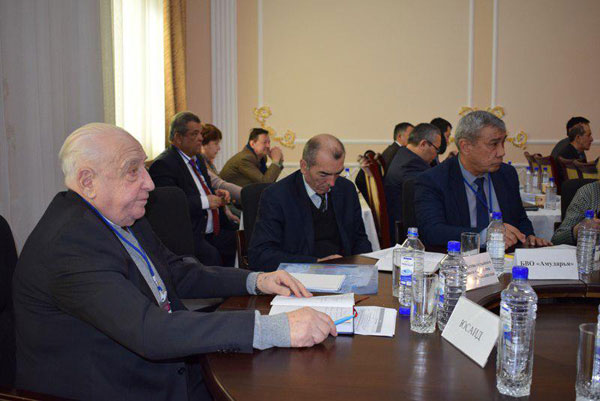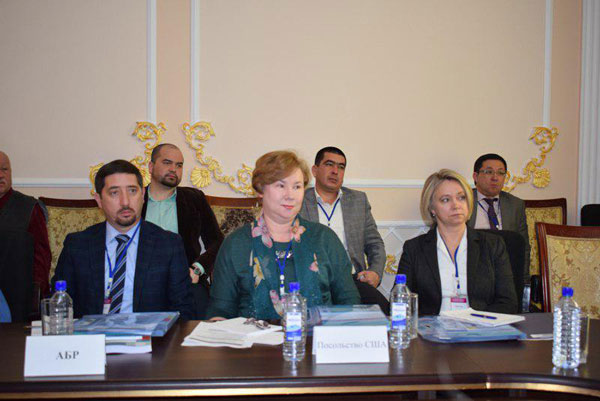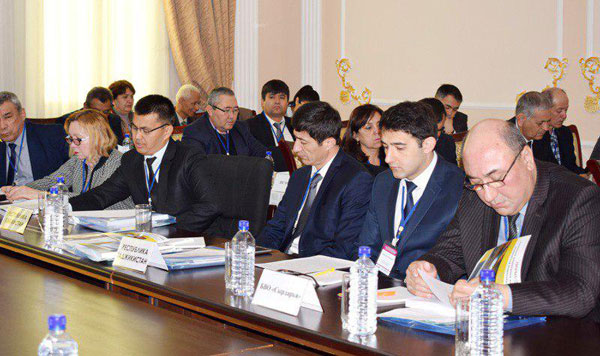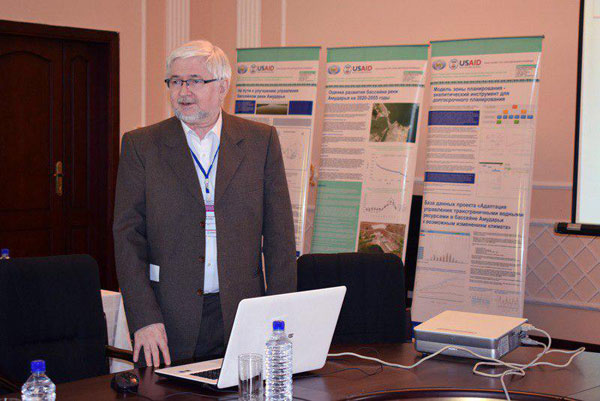FINAL WORKSHOP "TRANSBOUNDARY WATER MANAGEMENT ADAPTATION IN THE AMUDARYA RIVER BASIN TO CLIMATE CHANGE AND FUTURE CHALLENGES: TOOLS AND RECOMMENDATIONS"
The final workshop under the PEER Project “Transboundary Water Management Adaptation in the Amudarya River Basin to Climate Change Uncertainties” (hereinafter, PEER Project) was held in the city of Tashkent on 31 January – 1 February 2018. This research project was implemented by SIC ICWC of Central Asia together with BWO Amudarya and the Analytical Agency “Ynanch-Vepa” (Turkmenistan) with the support of the U.S. Agency for International Development (USAID).
The main objective of the workshop was to discuss with key stakeholders the PEER Project results on comprehensive research and assessment of development in the riparian countries of the Amudarya basin and their respective individual zones by 2050 in the context of climate change. There was also exchange of future plans with key national, regional, and international partners in order to undertake coordinated and complementary actions for the improvement of water management and enhancement of cooperation in the Amudarya basin.

Participants of the workshop were represented by ministries and departments in Uzbekistan, Ministry of Energy and Water Resources (MEWR) of Tajikistan, regional organizations (IFAS Executive Committee, BWO Amudarya and its territorial branches in the riparian countries, SIC ICWC, and CAREC), Analytical Agency “Ynanch-Vepa” (Turkmenistan), Institute for Strategic and Inter-regional Studies under the President of the Republic of Uzbekistan, Tashkent Institute of Irrigation and Agricultural Mechanization Engineers (TIIAME), National University of Uzbekistan, US Embassy in Tashkent, and key international partners (ADB, GIZ, SDC, and IWMI).

The participants were welcomed by the representative of the Uzbek Ministry of Agriculture and Water Resources (MAWR), the USAID Country Director in Uzbekistan and the Director of SIC ICWC.
The Head of Water Sector Development and Water Conservation Technology Department of MAWR Mr. I.Ergashev thanked USAID for the support of the PEER program and the project executors for impressive results that would help to better adapt water management to climate change.
USAID Director in Uzbekistan Mr. Gary Robbins extended his appreciation to the partners from Uzbekistan for their cooperation under the PEER Program in the area of water resource management. In Central Asia and Afghanistan, there are 19 partnerships focused on water resources, including 6 in Uzbekistan. Some forecasts predict that by 2025, two-thirds of the world’s population could be living in water stressed conditions. Central Asia is no exception. Mr. Robbins expressed hope that the research results would be useful when making critical decisions.
Director of SIC ICWC Prof. V.A.Dukhovniy thanked the participants for their interest in research efforts held in the Amudarya Basin. He underlined that the main objective in the near future is to mobilize available knowledge and delivered results, attract attention of international financing institutions and donors, regional and national organizations and empower decision makers so that they could address problems encountered in the Amudarya Basin.

Session 1 “Water resource management in the Amudarya Basin” was opened by Prof. V.Dukhovniy with his key report on “The Amudarya River basin: current and future challenges”. In this report he pointed to recent specifics of water management in the basin and the opportunities to cover water shortage.
Then Deputy Head of BWO Amudarya Mrs. G.Tilyavova made her presentation on “Water management in the Amudarya basin in the context of growing water scarcity”. She underlined that climate changes gradually start impacting hydrological conditions in the basin – the wet and dry year cycle changed. In this context, the lack of data on all tributaries of the Amudarya and frequent disagreement of forecasts and actual data affect the water distribution plans. Hence, it is urgent to change approaches to water management, taking into account climate scenarios and their impact on river runoff and water requirements. There would be difficult to ensure timely and guaranteed water supply to users without efficient data sharing with national hydrometeorological services on operation modes of hydropower stations and accounting of open river channel losses.
Mr. F.Ikromi, water management expert from the Ministry of Energy and Water Resources of Tajikistan, spoke on national actions in water management in the Amudarya River Basin. He noted that under present conditions of climate change the project research and especially its results were of great interest for future actions to mitigate water shortage. The reporter also explained actions undertaken in Tajikistan to address the water shortage issue.
Mr. Z.Ishpulatov, head of division at the Ministry of Agriculture and Water Resources of Uzbekistan, presented the structure of water management in the republic that was reformed according to the President’s Decree of 4 August 2017. He underlined difficulties encountered during dry years in allocation of water between upper and lower basins of Amudarya, as well as arrangements between Uzbekistan and Turkmenistan. The reporter told on investments made in the water sector in the last decade, water conservation technologies implemented, measures to reclaim irrigated land, and priority directions of water sector development in the Republic.
Session 1 ended with presentation of SIC's modeling and climate change expert Mr. G.Solodkiy, who presented report of Mrs. N.Agaltseva on “Climate change in the Amudarya basin and its impact on water resources: REMO 0406 scenario, 2050”.
Session 2 addressed main project result. The head of SIC’s research division Mr. A.Sorokin in his presentation “PEER project and its comprehensive innovative approach to assessment: introduction to the project, research methodology and tools, scenarios” demonstrated scenario combinations of basin development (climate, water, crops, and innovations) and methodology of comprehensive research based on modeling of crop water requirements, productivity, HEPS operation modes, and channel balance.

Then Mr. Solodkiy made his presentation on “Technology of crop water requirement estimation used in the PEER Project” and explained methodology and technology for estimation of crop water requirements in the Amudarya basin. The research objects were planning zones located in the river basin. Climate change was considered through earlier results (Wurzburg University) derived from the REMO model. Crop water requirements were modeled by the REQWAT model in GIS-environment. The maps of planning zones, irrigated land, groundwater well location, and soil and the observation data on water table were used for calculations. The modeling results were presented in form of decade and monthly water requirements of various crops averaged by each planning zone or as maps of annual crop water requirements.
SIC’s climate expert Mrs. G.Stulina in her presentation “Positive effects of climate change on crop water requirements and crop water use in the Amudarya basin” demonstrated that climate change and temperature growth would change also the agroclimatic parameters determining crop growth and development. The research results allowed concluding that the observed growth of thermal potential ensured earlier sowing dates and accumulation of the sum of effective temperatures in shorter periods of time. This, first, would shorten plan development phases and the growing season as a whole and, second, reduce water consumption by plants. Given that such approach to assessment of crop water requirements will enable more accurate definition of water supply in the future, it is necessary to continue research in this direction.
SIC’s economist Mr. Sh.Muminov in his presentation “Socio-economic development, including agriculture, in the Amudarya basin and future scenarios” spoke on the main objectives and criteria of agricultural development forecasting in planning zones of the Amudarya basin until 2050 and reported on the long-term agricultural development strategy adopted recently in the Republic of Uzbekistan. Using Uzbekistan as a case-study, he demonstrated the results of demographic forecasts, growth of food demand, predictions of changes in crop acreage, yield, livestock heads and production, as well as production of main foodstuff per capita. He also underlined the effects of innovative water conservation technologies on average crop yields and water requirements.
Then, SIC’s modeling expert Mr. R.Khafazov made the presentation on “Modeling planning zone: model (local version, as part of ASBmm), interface, and testing”. He presented the planning zone model, an on-line analytical tool to analyze planning zones for different combinations of scenarios (climate, water, socio-economy, and innovations) over 2016-2055.
The major modeling results were explained by Mr. A.Sorokin in “Results of comprehensive research and scenario modeling: assessment of river flow in the Amudarya basin, alternative operation modes of reservoirs and HEPS, water balances of rivers and planning zones, water and land productivity for 2020-2050”. He showed key indicators of the comprehensive research of basin development using scenarios, provided recommendations on adaptation to climate change and transboundary water management in 2020-2050. Assessment of available water resources in the basin was given for 2020-2055, as well as water losses, water demand by economic sector, etc. The reporter also showed the results of assessment of energy balance in Tajikistan, including electricity demand and capacities to meet it under alternative scenarios of runoff regulation and HEPS operation. The economic effect of cooperation in the Amudarya basin was also demonstrated.
Deputy Director of SIC ICWC Ms. D.Ziganshina in her presentation “Adaptability of the water allocation system in the Amudarya basin to changing conditions: legal and institutional aspects” demonstrated the results of the analysis of legal and institutional frameworks of transboundary water management in the Amudarya basin. The reporter noted that from the legal point of view, comprehensive and systemic efforts are needed in three directions: (i) improve existing agreements and ensure their enforcement; (ii) take part actively, consciously and competently in lawmaking and law enforcement and avoid behavior that runs counter to norms and principles of international law; (iii) increase legal awareness and legal culture. Such comprehensive approach will contribute to building of legal relationships in order to transfer from disputes over potential impact of individual projects to coordinated work of riparian countries based on mutually agreed regional restrictions and shared vision of basin’s future.
The representative of the Analytical Agency “Ynanch-Vepa”, project partner, Mr. A.Berdiyev in his report “Adaptation practices and measures on water and climate change in Turkmenistan with focus on the Amudarya basin” presented key directions and sectors for mitigation of and adaptation to climate change as stated in the Turkmenistan National Strategy on climate change. He cited examples of undertaken measures, stated recommendations of the Agency for better effectiveness of efforts made. The key message of the presentation was that the highest effectiveness of adaptation measures could be achieved only in case of a comprehensive approach to management of both transboundary and national water resources.
The second session was finalized by the presentation of I.Beglov, R.Toshpulatov, and I.Ergashev on “The project web-site and database: structure, content”. They demonstrated the project web-site and database that contained actual data and basin development scenarios under the following categories: climate; water; hydropower and reservoir operation modes; water use of country planning zones; water balance’s elements; irrigated agriculture products, etc. The database was filled with retrospective data and modeling results. The knowledge base contains all information products developed in the project course: monograph; policy briefs; articles and presentations; maps.
Session 3 “Future development and interactions with partners” was started with the presentation of Prof. V. Dukhovniy on “Prospects of water sector development along the Amudarya River: summary for decision makers”. In this presentation, he presented recommendations that formed the basis of overall conclusions of given workshop.
Then, Mrs. G.Tilyavova made the report on “Proposals for improvement of water management in the Amudarya basin by territorial branches of BWO Amudarya in the context of climate change and future challenges”. She presented proposals for territorial branches of BWO Amudarya (in Tajikistan, Turkmenistan, and Uzbekistan) on adaptation of water management (planning, analysis) in the context of climate change, potential growth of water demand in Afghanistan and flow regulation by HEPS, and discontinued discharge of collector and drainage water from the left bank of the Amudarya in the middle reaches.
She also underlined the importance of and the need for equal distribution of water shortage in dry years, for enhancement of territorial branches by analytical tools, i.e. operational management models that would allow correct assessment of water losses and water travel time along the river and in the floodplain and calculate river balance for individual reaches.
Presentation “Water management experience of territorial branches of BWO Amudarya under conditions of water shortage” was made by Mr. T. Nurmagambetov, chief engineer of the Lower Amudarya branch of BWO Amudarya. He introduced the participants to operation of territorial branches under low-water conditions and difficulties they encounter. He also presented the results of reconstruction of the Takhiatash Hydroscheme to automate the system and monitor water level and flow rates. Finally, he noted advantages of automated data collection and processing for operative decisions on water distribution.
Director of the GIZ Program “Transboundary Water Management in Central Asia” Mrs. Caroline Milow made her report on “GIZ water-related activities in the Amudarya Basin between 2009-2017”, in which she briefly informed about the Berlin Process – a program offered by the German Federal Foreign Office for the Central Asian states and activities carried out under current phase III.
In the Amudarya basin, GIZ assists in strengthening technical capacities of BWO Amudarya and its branches by providing office facilities, supports BWO Working Groups activities with participation of representatives from Tajikistan and Turkmenistan, helps in raising awareness of stakeholders and communities on activities of BWO Amudarya, supports the establishment of BWO Amudarya web-site, and organizes trainings for BWO staff. In 2017, GIZ supported organization of the Amudarya River Day in Tajikistan, Turkmenistan, and Uzbekistan and the scientific conference “Amudarya – the River of Friendship and Cooperation”.
Mr. B.Rejepov, Deputy Chairman of the Executive Committee of IFAS (Turkmenistan), in his speech “Main approaches to elaboration of ASBP-4” informed about the meeting of the IFAS Board held the day before in Ashkhabad, the work plan adopted by EC IFAS during this meeting for the period of chairmanship of Turkmenistan, and the preparation of ASBP-4 addressed by the Board. He noted that regional and national work groups including bodies of ICWC and ICSD would be established for preparation of the Program and particular attention would be paid to regional projects.
Mr. O.Anarbekov (IWMI) in this presentation “Implications of climate change, land use and adaptation interventions on water resources and agricultural production in transboundary Amudarya River basin” spoke on implementation of the same-name PEER Cycle 5 Project. The project aims to assess impacts of land use, climate change and irrigation practices on water resources dynamics of Amudarya river basin through an integrated study. It consists of three components each aimed at addressing existing issues using field studies, remote sensing, and numerical modeling.
Prof. A.Salokhiddinov (TIIAME) in his presentation “Base assessment of risks and challenges in agriculture associated with climate change for Namangan and Fergana provinces of Uzbekistan” demonstrated results of the research undertaken in six districts of the Fergana Valley. Impacts of climate change on agriculture were studied by collecting (surveys) and processing information at farm level.
Overall Workshop Conclusions
1. By 2050, one should expect water shortage in the Amudarya basin within 6-9 km3 on average annual basis. Among major factors that potentially contribute to water amount, shortage, and intra-annual distribution are population growth in the riparian countries, potential growth of water use in Afghanistan, operation modes of large reservoirs with hydropower, and climate change.
2. Climate change is one of most important factors that should be taken into account in water use planning (revision of water use norms and consideration of positive effects of climate change on plant growing, etc.), water assessments (correction of hydrographs) and water management.
3. Improvement of water accounting accuracy and lowering of water losses in all chains of water distribution and management (from river channel, main canals to irrigation network and field) are the main reserves for compensation of future water shortages.
4. The legal framework for water cooperation and management needs to be improved. Among others, this concerns elaboration of basin agreement that will guarantee stable national economy growth on the basis of basin’s water and aquatic ecosystem preservation for future generations.
5. It is necessary to develop a basin strategy, a package of regulatory documents and rules for water management in the basin (including shift to multiyear flow regulation by reservoirs), procedures for agreement upon operation modes of hydroschemes, and mechanisms for on-line data exchange.
6. Measures and procedures of social control over water conservation and water and energy use (including water consumers, environmentalists, energy sector and other stakeholders) need to be developed and adopted.
7. It is important to regularly and systematically build capacities of water-management organizations, including provision of information, open and regular exchange of data and information, education of water users and consumers, and training of the staff of water-management organizations at all levels.
8. Fostering an attitude of care towards water following the rules and customs of our ancestors must become our common objective. Water is a sacred object that needs to be conserved and protected.
9. Further research efforts are needed to study in details and on integrated basis the issues identified by the project and address them. Particularly, it is proposed to initiate a regional project for development and adoption of a mutually-agreed common methodology for revision of hydromodule zoning, estimation of water consumption norms and crop irrigation scheduling, as well as for more precise definition of crop coefficients depending on varieties and zonal location.
Photo by D. Chirkova
|